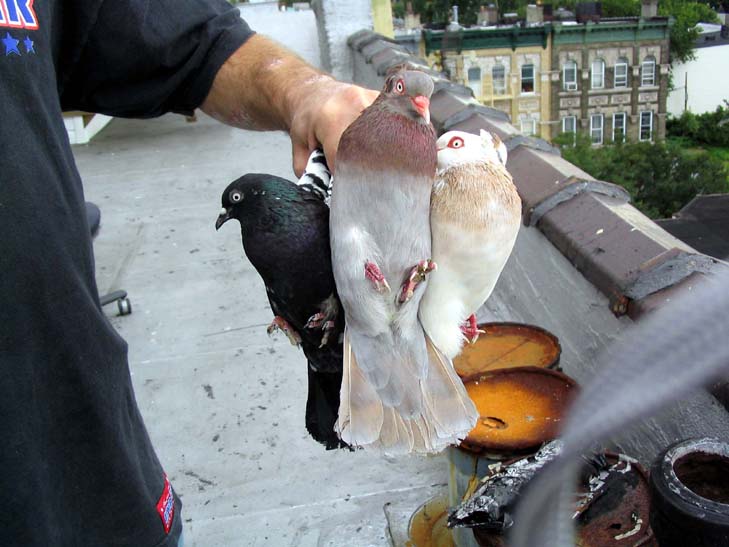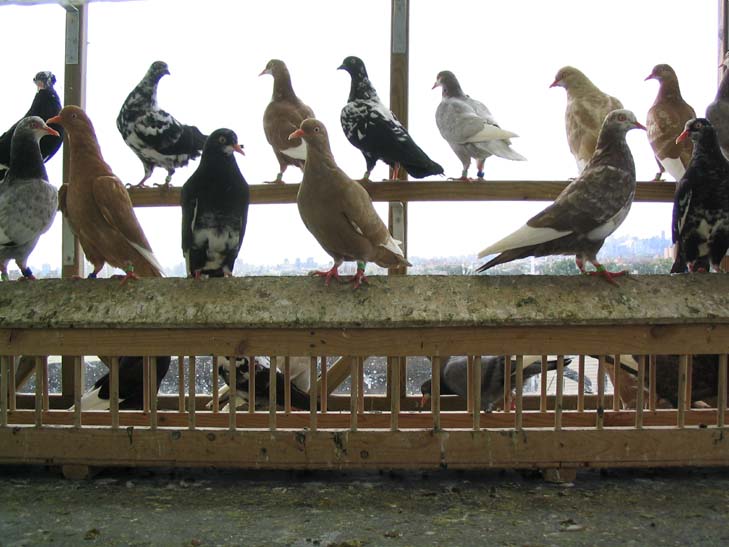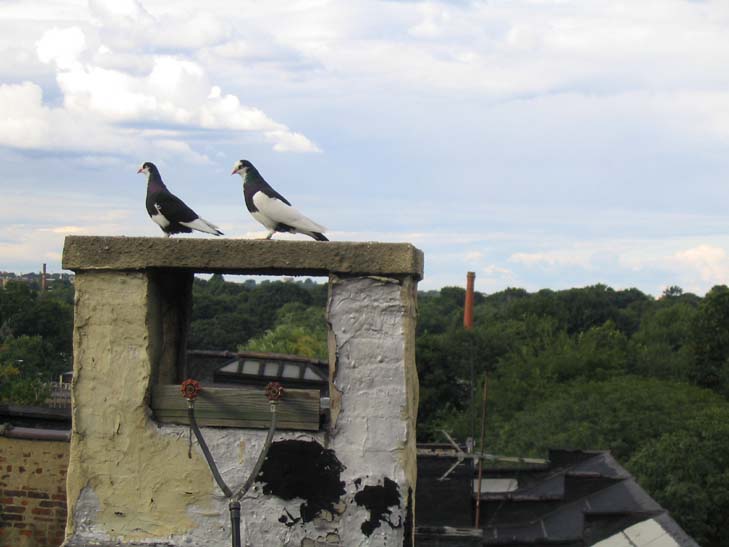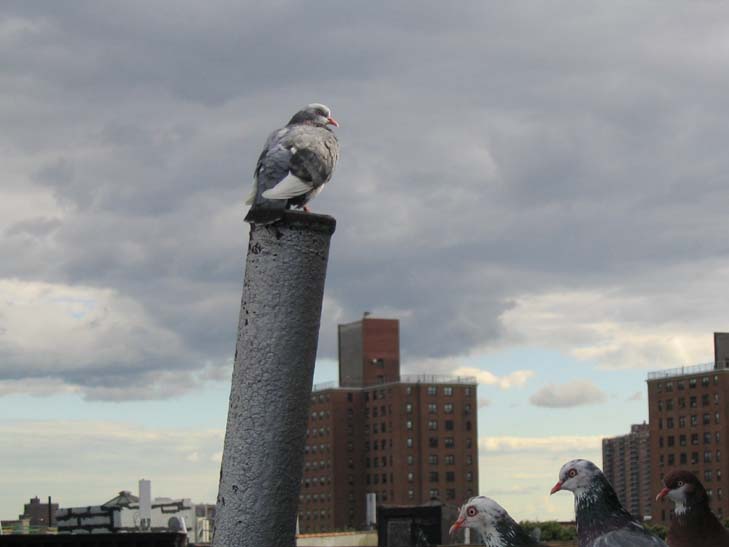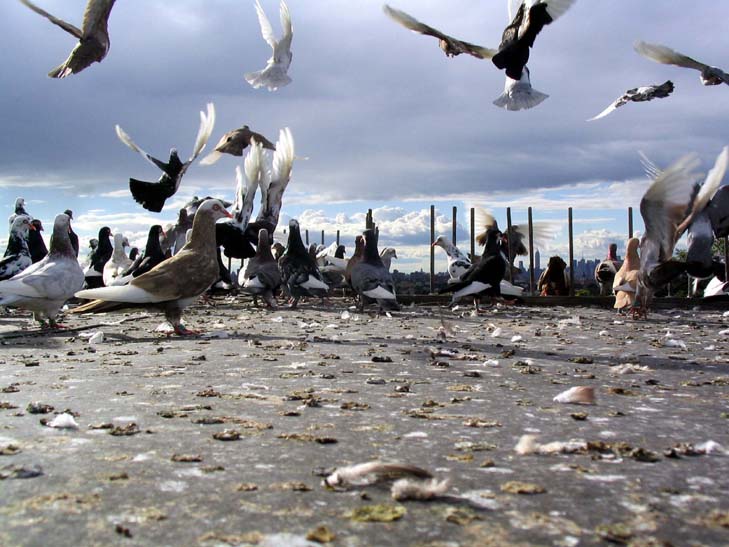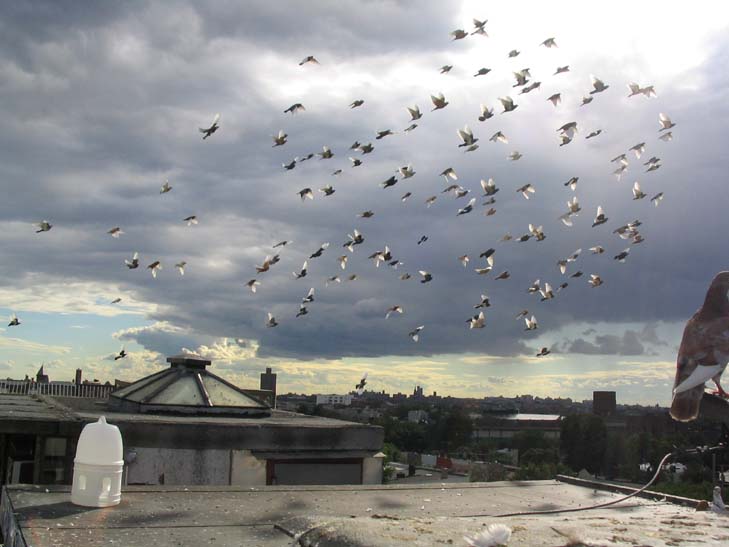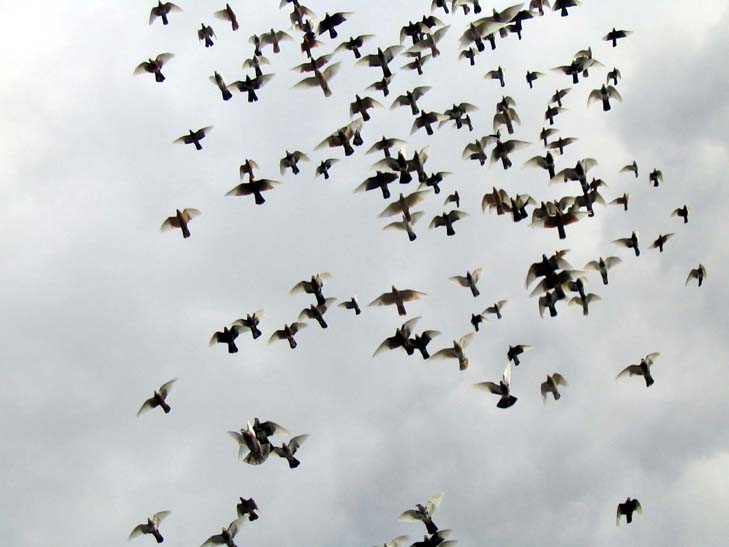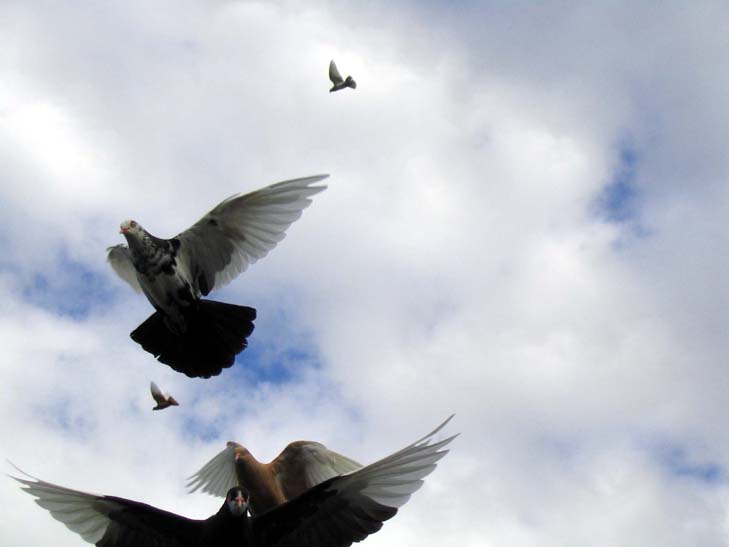The pigeon wars are raging high in the sky over Brooklyn. It’s the end of summer, and the weather’s just right. That’s the word at Broadway Pigeon. Rick lost quite a few birds last night but gained some back. Mikey came out with 12 over. Everybody’s counting. The bands on the pigeons’ legs make it clear where they came from. A gold band might announce that a bird belonged to Dream Team II: the Bushwick Hellhole. Another might have come from Big Bob, Broadway & E. Flushing. Chico from Halsey. Pepi & Son’s, Bronx, N.Y.
The pigeon shop is in between the neighborhoods of Bedford-Stuyvesant and East Bushwick. The J subway train rumbles overhead, loud enough so people pause mid-sentence, clear their throat, and take a sip from a cool bottle before picking up where they left off. Joey Scott, a co-owner of the store, parks his ancient Econoline van in front of the store and walks in with a cage holding two large pigeons, both white, a cock and a hen. Bruce, an older black gentleman sporting a blue cap follows him in. Joey takes some money out of the register and hands it to Bruce for the birds. Bruce has decided he doesn’t want them anymore. As a matter of fact, Bruce has just given up all of his coops; he came back from a vacation in Mexico and decided he is too old to keep the birds.
“I had birds since I was nine years old,” Bruce says. “I’m 52 now. I can’t go on carrying a hundred pounds of bird food up the stairs, back and forth.” He points at the two birds in the cage. “Those are too big to fly like the others. I don’t know what to do with them. They had eggs, but not enough space. The eggs got crushed.” He shakes his head. “My days are over.”
A man with a cowboy hat asks him, “You took pictures of the coops? Lots of memories, huh?”
“I had the coops since I was nine years old,” he reiterated. “Took the coops down.”
“What you gonna do next?”
“Not gonna do this,” he says, looking at the birds. They’re now Joey’s.
Joey may be able to offload them here at the shop or down at the chicken market. For now they’ll be set aside from the main pigeon loft in the back room. The setup is sizeable: two levels about 12 to 14 feet high altogether, with four separate coops in the bottom row, each populated by hundreds of white pigeons with streaks of either reddish or black feathers. On three sides of the coops are six-foot shelves, with each row spaced for a pigeon’s height. When not taking a stroll on the floor, the birds like to stand on the shelves, their feet gripping the edge. Upstairs is another set of coops Joey rents out to owners who are on vacation. The ventilating fan whirls in the back. Little fuzzes of feather drift down like snowflakes.
A kid with a black skullcap exclaims, “There were some nice birds flying.”
Rico, wearing a shirt emblazoned with the Puerto Rican flag, bursts out, “This is the last stand. You gotta show them this is the last stand!”
“You’re gonna lose and you’re gonna catch.”
Rico raises his hands. “The sky’s the limit, baby!”
Joey looks up from his lunch of chicken nuggets and says, “Yeah, you should have been here last night. The pigeon wars were happening. Every coop was rolling out. The sky was full of birds.”
{divider}
Joey co-owns Broadway Pigeons with his brother Mikey Scott, who spends most of his time running a deli in New Jersey. Joey comes in every day, just T-shirt and jeans to go with his close-cropped hair, and takes care of managing the store while Mikey, who has a keen eye for good pigeons, decides which birds to keep when new ones are caught or brought in. Some families have generations of firemen, policemen, or doctors. For Joey and his brother, it is pigeon-keeping that was passed down the bloodline from their Italian grandfather and likely from his forefathers, skipping their father but now indomitably running through them. Mikey started taking care of birds when he was two years old. Joey’s new to the sport—he started 10 years ago.
The relationship between man and Columbiformes, though, is much older. In the Columbidae family there are more than 300 species of doves and pigeons, terms that can be used interchangeably. The ancestral species for the domestic pigeon is Columba livia, or the rock dove, whose original range extended from northern Africa to Iran to Scotland. Pigeons are the precursors to modern-day text messaging. Ancient Egyptians made rooftop dovecotes out of straw and mud, and developed a special form of paper for their pigeons to carry. At the first Olympic games in 776 B.C., every athlete brought a homing pigeon from his village. If he won his event, his would be the bird that carried the news home.
Most people associate the pigeon’s finest hours with its use in human wars. In the pigeon version of the hall of fame, Cher Ami stands out for his actions at Verdun in 1918. Shot through the breast by a German bullet, with a message capsule barely dangling from the shattered ligaments of his leg, Cher Ami still found the American headquarters 25 miles away. The message read: We are along the road parallel to 276.4. Our own artillery is dropping a barrage directly on us. For heaven’s sake, stop it. Having saved 194 American lives, Cher Ami was awarded the Croix de Guerre.
What gives a pigeon the aptitude for precise and eventual return? In an 1886 article in Century magazine, writer E.S. Starr proposed: “[It] is by its keen sight and wonderful memory, directed by its intelligence and poised by perfect physical condition, that it answers to the demand of the governing impulse of its nature—the love of home.”
The game Joey and his brother and friends play in the skies above Brooklyn is a variation on this intelligence. The war isn’t just a race of distance. Not even the same pigeons are used. The war is a lower-stakes continuation of a game once played in Modena, Italy, called the Triganieri (where the losers’ birds were killed) and a relative of a game still played in the Turkish city of Urfa (involving over 500 flocks of birds). The Brooklyn Pigeon Wars, as they call it, is an aerial social casino. To play, a coop owner releases all or a portion of his pigeons, letting them fly freely in a flock over Brooklyn, meeting up with similar flocks released by other owners. An intricate dance ensues. The flocks intermix. No one knows what actually happens in bird-speak up there in the sky, but perhaps the pigeons are saying to each other, “What’s up. Like my style? We got a real happening crib. Great view. Come back home with us and we’ll show you where it’s at.” At a certain point the flocks turn homeward, arriving lesser or greater in number than they started out. A captured bird’s fate depends on the victorious owner. It might be kept and trained to fly with the new flock, or it might be ransomed. A coop owner might lose half his flock in one night, while others gain as many. This is how birds are lost and won.
{divider}
At the shop, Joey sells other pet supplies to supplement his pigeon-related income—dog collars, flea sprays, and fish tanks—but no other animals aside from the birds. These other supplies he keeps at the front of the store, almost as if there’s an invisible partition between pigeons and the rest of the animal kingdom. A lady comes in asking if he has a starter kit for an aquarium.
“What’cha mean you don’t sell no fish?”
“I don’t have any fish here.”
“You know where I can buy fish?”
“Other stores probably.”
“Oh, I know. I can get fish on Murder Avenue,” she answers herself and walks out, presumably heading towards Myrtle.
In the backroom, George is eyeing a set of birds. He rode over the Williamsburg Bridge on his bike to get some more to add to his flock of 18. He lives in a high-rise housing project in Alphabet City in Manhattan, where his 11th-floor window acts as the trap door between the sky and a walk-in closet converted into a full-time coop.
“They way I train them, they fly out and they fly back in. I don’t want no birds to sit on no roof. Any bird that bunks like that I don’t keep.”
Joey explains, “One bird just goes out and sits there across the street. Other birds see him and go, ‘Why am I flying?’ and the next thing you know they all start sitting. You don’t want that to happen. I get rid of the ones that bunk.”
The phone rings and Joey goes to pick it up, just as three huge guys walk in the door. One is a retired cop who was in the force for 20 years. He’s with his buddies, each of them clutching a brown-bagged beverage.
“Hear you got my birds. I’m missing about 50,” he kids.
“Like Rick last night?” Joey asks. “Yeah, Rick lost maybe 60, 70, a hundred, and caught maybe 30. My brother got some. The rest were all other people’s.”
Everyone’s now convened in the backroom. The ex-cop peers into the coop, and looks up at the homing pigeons someone paid Joey to take care of. He and his friends take a sip as they watch Joey open the cage and walk in with a scoop of feed in an old Maxwell House can. Immediately, every bird swoops to the floor.
“There must have been 30 coops rolling out last night,” Joe says. “One person rolled out. The others tried to hit him. The flocks got confused. Then the other guys looked out and saw the flocks and released their birds, too. They all tried to hit each other.”
The ex-cop and his friends stay a while but don’t buy anything. Joey slaps a round of low-fives with them as they leave.
The phone rings, but Joey doesn’t pick up because another customer has just walked in, an old lady wearing sunglasses over her prescription glasses. She wants dog shampoo but doesn’t know which one to get.
“Aw shit, I oughta just kill my dog,” she cries.
The phone rings again. Joey’s still with the old lady. Just above the ringing phone are pictures of local coops tacked onto the wall. Some are huge, covering almost the entire length of a roof. One is painted yellow, like a brand new taxicab. There’s a picture of a pair of prize birds. There are pictures of people at the shop. In one of them, Mike Tyson stands front and center, a fellow coop owner surrounded by a posse of the same.
It’s almost closing time. Joey puts on a dust mask and begins to fill the feeders. The back room echoes with the sound of fluttering wings. The birds crowd on the floor, stepping over each other for a peck of feed. It’s not surprising why Hitchcock saw the fear potential in birds: Given the sharpness of the claws and beaks, the birds don’t know what they’re capable of. Joey’s alone in the coops. He stands like an awakened Gulliver. The multitude swarms at his feet—there must be a few hundred in there. These aren’t even the birds he flies on a regular basis.
“Between my brother and I, we probably have over a thousand birds. I might lose 175 in one shot. Next day, my brother rolls out his birds, maybe loses 150, but you catch and you lose. It all evens out.”
He fills the water stations and throws some birds into a bigger cage. Then he turns off the lights.
“Let’s go.”
{divider}
It’s nearly six and the summer sun has disappeared behind a wall of clouds. The views are sweeping. The Manhattan skyline hangs far on the horizon. The lonely, tiny silhouette of the Williamsburg Savings Bank building juts out to the left. Just to the north of the roof we’re standing on is the Cemetery of the Evergreens. The apartment building with the rooftop coop is part of the hill that rises to the cemetery.
“Look at the trees,” says Joey. “When the branches are bending like that, the winds get the birds tired. People are going to lose birds.”
Tito agrees. “We are high here. The wind has to come this way for those birds to come, you know.”
Tito takes care of these birds for Joey and Mikey, who own the building. He lives there as a superintendent and comes up every day to fly. Their birds are known as the Pet Shop Birds, tagged with a light green leg band. Other coops have bands of all sorts of colors. Tito shows me a jar filled to the brim with the colorful bands clipped off of captured birds.
“I’ve kept birds since I was 12 years old,” Tito says. “I’m now 50.”
He points toward Manhattan. “Look.” Then he points in another direction. “Look.” Then he points again at a different place. “Look. Look.”
At first, the flocks aren’t easy to spot, but then the black dots whirling in the low sky become visible. The black dots turn in unison, left and right, as if they are all tied to the same string. Many coops have rolled out their birds this afternoon. There must be half a dozen flocks out there. The flocks become more visible against a white cloud, but when the sun shines a certain way, the light catches on the wings and the flocks shine white. They circle around a roof, but then slowly spiral out toward other places, depending on how the wind is blowing or whatever catches the instinctive fancy of like minds. They look like little tornadoes.
“Look at the clouds,” says Tito. “About 200 birds right there. C’mon, keep flipping. Keep flipping. This way. This way.”
“Whose birds are those?” Joey asks.
“That’s Indian Joe’s. And those are Rick’s. That’s Outlaw Mikey’s. And those are Swappy’s.”
The Pet Shop birds are still perched on the roof, clutching to the tar-laid edges. They aren’t like your everyday pigeons. The coloration on their feathers is mostly white with black or ash-red flairs. They are leaner. They don’t seem restless like the usual street pigeons—they don’t fly until there’s a reason to fly. A flotilla of noisy motorcycles careens down the street below, but the birds don’t move.
“When I was teenage,” Tito reminisces, “I had birds that go out to Coney Island, Maspeth, downtown, all the way out to Kennedy Airport, and they’d come back. You train them well and they come back. It takes years to get a flock like that.”
He opens a shed and shows off his feeding materials.
“I give ‘em garlic powder. It purifies the blood. I have vitamins and minerals. Wheat germ oil. Grit helps make better eggs. Sometimes they get this sickness they call parathyphus. I have to give them this vaccine here. You see this? This is an iron solution for the blood. This is the same kind they give to horses at racetracks.”
He puts the bottles back and pulls a pair of binoculars to his face. In the distance, a flock moves closer. “If those guys there don’t crack them, then there’s a possibility of us cracking them.”
He turns and looks through the binoculars at another flock twisting and turning about two miles away.
“It’s the sport, you know, the training. See how far you can go, whether the winds blow north, south, west, whatever. They come home. They’ll bring other birds, too.”
He lets the binoculars hang from his neck and takes out a cigarette. He lights it and squints as he inhales. He’s scanning the sky. The wind picks up, and the tops of trees begin to sway. The sun reappears again, for a moment, and then hides behind the clouds.
All of a sudden, the Pet Shop birds take off.
